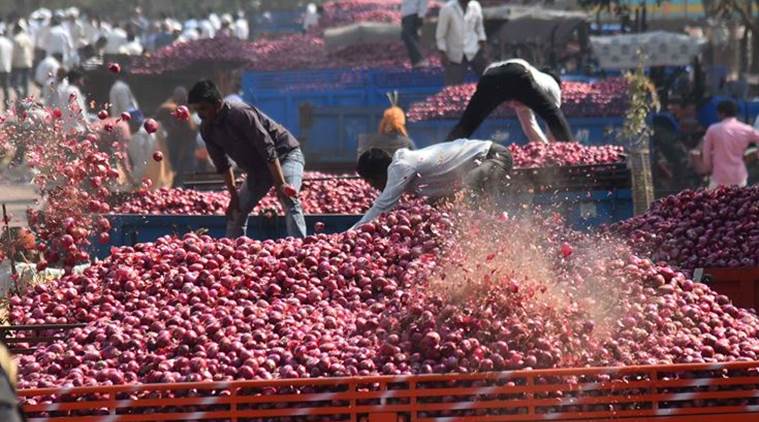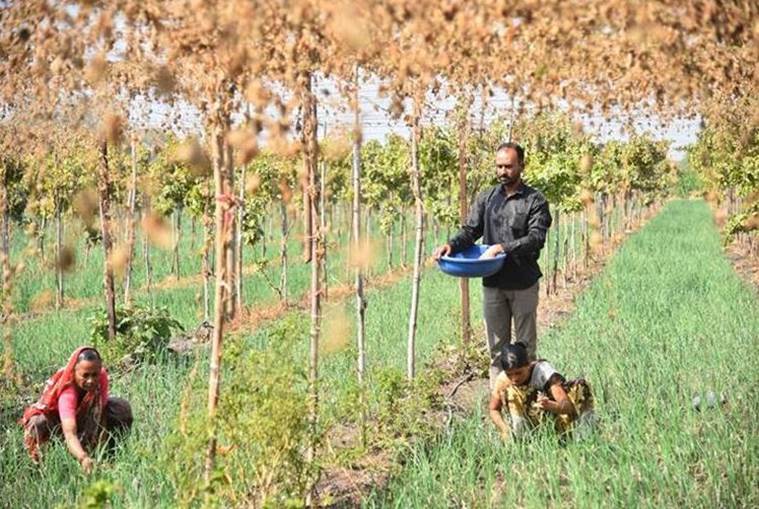As Santosh Gorade, 38, tends to his 3.5 acres of onion crop, he says he will do this for “maximum six-seven years more”. After that, the farmer from Takli Vinchur village in Nashik plans to get out of farming. “It’s too volatile and market forces are always against us,” he sighs. Under no circumstances, he adds, does he want his two sons, Pranav, 10, and Karanvir, 5, to take up farming. “There is no future in this.”
In the past two years, this volatility in the markets has left onion farmers battling penury. Maharashtra is the largest producer of onions in the country, contributing 30 per cent of the total, while Nashik accounts for 60 per cent of the onion area in the state. Nearby Lasalgaon is the largest wholesale onion market in the country.


Gorade says the Budget this year, with its Operation Greens, or PM Modi’s TOP talk, mean little, when the biggest villain for onion farmers is the government. Regimes have been known to fall on onion prices, and farmers complain of the government repeatedly intervening to bring prices down in times of flush, and staying silent when prices plunge.
Story continues below this ad
“Before launching Operation Greens, someone should explain why onion keeps being put under the Essential Commodities Act. This allows the government to declare stock limits and intervene for price manipulation,” says Gorade. “We know onion is a politically sensitive crop, but the farmer too must be thought of.”
READ | The PM said tomato, onion and potato crops are government’s “top priority”. As they count their losses, farmers in TOP zones are waiting to see how
 Santosh Gorade, who also grows grapes, says he wouldn’t want his sons to do this work ever (Express Photo/Mayur Bargaje)
Santosh Gorade, who also grows grapes, says he wouldn’t want his sons to do this work ever (Express Photo/Mayur Bargaje)
Before the Gujarat elections in December 2017, the Minimum Export Price (MEP) of onion was set at a whopping $850 per tonne, a move meant to discourage exports to stabilise prices. Dipak Pagar, director of the Nampur wholesale market in Nashik, says, “Days earlier to it, the average traded price of onion was around Rs 35 per kg. After the MEP, prices corrected to Rs 25-24 per kg.”
READ | Prices unsteady, Andhra Pradesh tries a seed experiment
That MEP was removed only early this month.
Till two years ago, Gorade would grow onion all three seasons — kharif (June-July, with harvest in September), late kharif (September-October, with harvesting post-December) and rabi (December-mid January, with harvest post-March). It’s only the rabi onion which is amenable to storage, and it’s this onion that feeds the market from April till new produce hits the markets after August.
Story continues below this ad
Heavy losses in 2015-16 broke the onion cycle for Gorade. “I was forced to sell my rabi onions for Rs 2-3 per kg, against production cost of Rs 9.50, which wiped out my savings and left me in debt,” he says. In 2016, Gorade kept away from onion and diversified part of his land to develop a nursery.
READ | Ahead of harvest, memory of rotting potatoes in 2017 leaves farmers ‘nervous’
But in 2017, Gorade’s vineyards suffered heavy losses due to rains, while onion prices firmed up in June, and so he is giving onion another shot.
Gorade notes that the low prices in 2015-2016 followed another announcement of MEP, at $300 per tonne, in end-2014. “Prices fell and remained low, despite the government removing export restrictions by end of December 2015,” he says.
Story continues below this ad
In November 2017, apart from the $850 MEP, the 38-year-old says, “For the first time in Nashik, Income Tax sleuths conducted raids to look for stored onions at traders’ godowns.”
About the removal of the MEP a few days ago, Gorade says, “By far, it was the fastest removal of MEP I have seen in my 20 years of onion trade. If it had not been done, the markets would have seen a bloodbath.”
Of India’s average production of over 200 lakh tonnes of onion, more than 180 lakh tonnes is consumed at home. Just about 10-15 per cent is exported. In 2017, till October, before the MEP was imposed, 16.79 lakh tonnes of onion had been exported.
Farmers from Takli Vinchur normally take their produce to the Lasalgaon wholesale market. Onion is currently trading there at Rs 18.46 per kg, down from Rs 28.62 kg in January. Gorade is not sure if the prices will last, given that another bumper crop is in the offing.
Story continues below this ad
About the possibility of post-harvest processing of the bulb, Gorade says, “Onion powder has demand in Europe, but who will buy it in India?”
Above all, he adds, what onion farmers need is for the sector to be freed of frequent government intervention. “It becomes news when onion prices go up, but when we suffer, there is hardly any attention, both from the media and government.”

 At Lasalgaon, the country’s largest wholesale onion market (Express Photo/Mayur Bargaje)
At Lasalgaon, the country’s largest wholesale onion market (Express Photo/Mayur Bargaje)

 Santosh Gorade, who also grows grapes, says he wouldn’t want his sons to do this work ever (Express Photo/Mayur Bargaje)
Santosh Gorade, who also grows grapes, says he wouldn’t want his sons to do this work ever (Express Photo/Mayur Bargaje)





